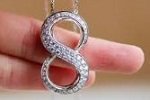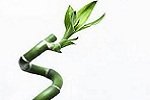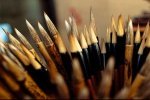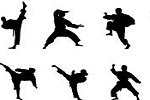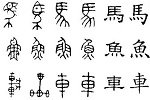Chinese New Year Symbols
Home ![]() Chinese Culture
Chinese Culture ![]() New Year Symbols
New Year Symbols
Chinese New Year symbols are inseperable from Chinese Spring festival, or Chun Jie in Mandarin.
There are quite a few symbols that are assocciated with Chinese New Year, and each of these symbols has its own importance and deep meaning. One thing in common is that they are all point to prosperity and happiness.
While the New Year might be about a list of resolutions for some, it's about hope for many others. Chinese New Year symbols are folks' ways to use common objects that are bestowed with meanings to give fate a push in the right direction. People place their hopes on these symbols and wish the New Year is a new beginning of a good life.
We present two sets of Chinese symbols here. One set is for celebrations, one has character symbols that implies luck, prosperity and happiness. Some of the symbols are includes in both catagories.
Here are some of the top most used lucky symbols. The following are the common symbols of a Chinese New Year Celebration:
- Spring couplets - Chunlian or Chun Lian
- Red envelope
- Chinese calendar
- Lucky character
- Plum blossoms
- Lucky bamboo
- Tangerines (or oranges):The reason why tangerine is one of the Chinese New Year symbols is that it sounds like "auspicious" in Mandarin. Thus tangerines are frequently acquired and displayed in homes and stores during Spring Festival time for their symbolic meaning of good luck and wealth.
- Tray of Togetherness
- Chinese sacred lily (Water Narcissus)
- Chinese Zodiac: This Chinese New Year symbol uses a rotating cycle of twelve animal signs to name the years. It is widely used by Chinese folks.
- Symbolic dishes
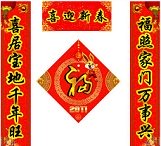 The well used lucky character
The well used lucky character ![]() is Fu (sounds like "Foo"). It's a indispensable Chinese New Year symbol that means good luck, blessings, and good fortune and is often displayed in many homes and storefronts, either accompanying spring couplets or standing alone.
is Fu (sounds like "Foo"). It's a indispensable Chinese New Year symbol that means good luck, blessings, and good fortune and is often displayed in many homes and storefronts, either accompanying spring couplets or standing alone.
And the way to display it is peculiar. People normally hang it in the center of their door like shown on the right picture, either with spring couplets or standing alone, and hang it upside down like shown in the picture below.
 To put something upside down may feel strange to people who are not familiar with the custom. But to the Chinese, there is a very auspicious reason behind. "Upside down" in Mandarin is a single character homophone to the character that means "come". When you go to visit a family or a store and tell the host or the owner that their Fu is upside down in Mandarin, you're basically saying "your blessing/fortune/luck is coming." And it indeed is a pretty good greeting.
To put something upside down may feel strange to people who are not familiar with the custom. But to the Chinese, there is a very auspicious reason behind. "Upside down" in Mandarin is a single character homophone to the character that means "come". When you go to visit a family or a store and tell the host or the owner that their Fu is upside down in Mandarin, you're basically saying "your blessing/fortune/luck is coming." And it indeed is a pretty good greeting.
The lucky character is usually written by brush on a diamond-shaped piece of red paper. It comes with various writing styles. Like spring couplets, people can either buy it or have a person who is good at calligraphy to write it.
Plum blossoms are called Mei Hua in Mandarin. Mei sounds like "may". It is one of the four Chinese national plants that have symbolic spritual meanings. They often appear in Chinese literature, songs, art and stories.
Plum blossoms burst forth at the end of winter on a seemingly lifeless branch when the weather can still be pretty bleak. The beauty of the flower and the severity of the weather forms a strong contraction. People appreciate its brave beauty and praised it in some well known poems and literatures.
As the time went by, it gradually became a Chinese New Year's symbol for courage and hope, which suits the spirit of a New Year.
Among all the Chinese New Year's symbols, this one is not very obvious.
It is a hospitality custom to prepare a tray of dried fruits, candies and nuts during Spring Festival and serve when visitors come. This tray is called a chuen-hop by many, meaning "tray of togetherness".
The common nuts prepared are peanuts, sunflower seeds, cashews, pinecone seeds, etc. Many families have sweets made with candy and nuts. This Chinese New Year symbol was traditionally made up of eight compartments. Eight is considered auspicious number by Chinese, because it sounds like "prosperous". That's why eight and its combinations such as 88 and 888 are very hot for adresses, car license numbers and phone numbers.
In the eight apartments, a special food item is filled and each has its own symbolic meaning and good wish to the New Year. For this tradition, the older people are more aware of it and tend to consciously to maintain the tradition while the younger generation see it more as a way to show your hospitality and choose trays with any style such as a China's map (shown as below), and any number of apartments they like.
 Modern Trays of Togetherness
Modern Trays of Togetherness
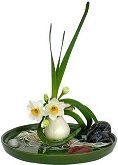 The Chinese sacred lily is a Chinese New Year symbol that signifies good luck and fortune.
The Chinese sacred lily is a Chinese New Year symbol that signifies good luck and fortune.
The Chinese sacred lily is actually water narcissus that blossoms at New Year's time. It is an important element in the Chinese Spring Festival. People buy the flower before the Chinese New Year, believing and hoping it blooms on the first day of the lunar new year to bring the best luck to them for the ensuing twelve months.
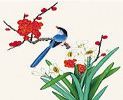
It can be arranged in an artistic way to bring out the best look of this flower.
On the right is a painting that puts two of the Chinese New Year symbols, plum blossoms and narsissus, as well as a song bird together for a good wish to the New Year.
Also see:
- Chinese Zodiac Symbols
- Chinese Symbol for Aquarius
- Chinese Symbol for Peace
- Chinese Symbol for Love
- Chinese Symbol for Scorpio
Home ![]() Chinese Culture
Chinese Culture ![]() Chinese New Year Symbols
Chinese New Year Symbols

New York Pass With More than 50 Sttractions

Southern California CityPASS saves you 32% for Disneyland, Universal Studios and 3 other attractions

